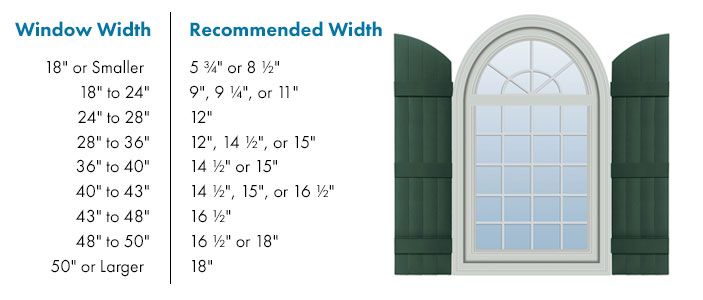How to Measure For Exterior Shutters
Step 1: Are the exterior shutters going to be functional or decorative?
Around 90% of all exterior shutter purchased will be installed in a manner that gives the appearance of functionality, but will never be closed over the window opening and therefore will not be functional.
The method used to measure for exterior shutters that function and the one used when the exterior shutters are not functioning, or fixed mount, are very similar. The biggest difference is that when exterior shutters swing open and close over a window opening, the width and lengths have to be precise. When the exterior shutters are going to appear to function, the authenticity of the shutter installation can be preserved while avoiding undue custom shutter charges.
Decorative Shutters
When measuring for decorative exterior shutters, it is always a good idea to have a goal for what you want to accomplish with adding exterior shutters to your home. Do you want an added sense of style and color? Do you want to enhance architectural details? Do you want decorative exterior shutters to look as if they are completely functional? Whatever your goal may be, a good starting point is to look around your neighborhood and take note what other homes of similar architectural style have done with their curb appeal; this will help you get an idea of what will work best for your home.
Operable Shutters
If the shutters are going to function, it is important to allow for hinges and spacing between shutters by subtracting clearances from opening width before calculating for exterior shutter width. Also, the exterior shutter must be the exact width or it might compromise the integrity of the shutters in order to function properly.
Step 2: Measuring for Exterior Shutters


Shutter Width
When choosing the width of your exterior shutters, you should take into consideration the width of the window and the distance the windows are spaced apart. It is generally best to find a single width that works for all of your windows. The width that usually works best for decorative shutter is between 25% and 33% of the total width of your window including the window trim. If the exterior shutters are not going to function, then you can decide which width and length you desire while using the table and pictures below as a guideline.
If you prefer to make your exterior shutters look operable, find a width that is close to 50% of the size of the glass and the window frame only, excluding the window trim. Make sure to measure the window vertically and horizontally to find the correct size you need.
Shutter Height
In most cases, decorative exterior shutter height is most appropriate when it is from the top to the bottom of the window trim. If there is a sill at the bottom of the window, exclude its height from your measurements as you want to maintain the appearance that the shutters will close over the window.

Shutter Width
Measure your windows as if the shutters were actually closed over them. This requires you to measure both the width and the height at three different points, since most windows are not perfectly rectangular or square.
As shown in the diagram, measure the window at three different points: top, middle, and bottom. If your three measurements are different, use the SMALLEST measurement. This measurement is this divided by two to give you the operable shutter width. For example, if your window width is 31" wide at its narrowest point, you should order 15 ½" wide shutters (31 ÷ 2 = 15.5). Traditionally; the method for determining shutter width is as follows:
Exterior Shutter Width = Opening Width - Clearances (if any) ÷ (# of windows × 2)

Shutter Height
As shown in the picture, measure the window at three different points: left, middle, and right, disregarding any window sills, if you have one. If you have different measurements, use the SMALLEST of the three for your height measurement.

Step 3: What hardware is going to be used to install the custom exterior shutters?
It is important to determine what hardware will be used before measuring for the exterior shutter installation if the shutters will be functioning. Understanding the shutter hardware mounting location is essential to getting accurate measurements. The diagram below shows the most common exterior shutter installations.
Projected: The exterior shutters are going to function so that in the closed position they will cover the opening. Notice that the pintle offset is greater than the other examples. This creates depth and allows the shutter to close without binding with the edge of the structure. The projected installation example is the easiest for measuring because there is no trim or structure to dictate the measurements.

Recessed: The exterior shutters are going to function so that in the closed position the shutters are going to be between the trim around the windows. Thus the measurements must be made from the inside trim for width and height. It is important to recognize the depth created by the trim and the depth of the shutter might be greater than that of the trim. If this problem exists, then combining pintle and hinge offsets can create more depth as in the projected example.

Flush: The exterior shutters are going to function so that in the closed position the outside edge of the shutters is flush with the surface of the structure. Thus the measurement must be made between the inside edges of the opening of the structure for width and height. It is important to recognize the depth of the opening as the depth of the shutter might be greater than that of the opening. If this problem exists, then combining pintle and hinge offsets can create more depth as in the projected example.

By following this guide, how sure can I be that my shutters will be ordered correctly?
This is just a guide intended to explain the principles involved in measuring for exterior shutter installations. Accuracy depends on the correctness of your measuring.
This guide is intended for general installations and may not work for all. We recommend using a licensed contractor for installation of all products to ensure you're covered.
Hooks & Lattice cannot be held liable for any damages

